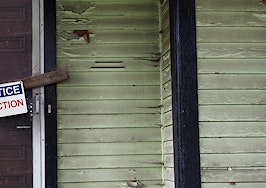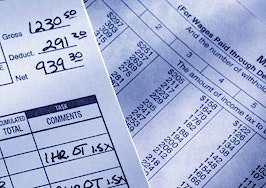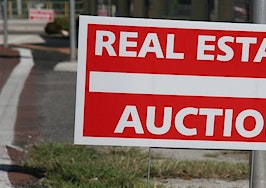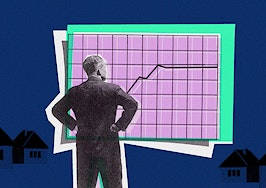- In the first six months of 2016, there were a total of 533,813 U.S. properties with foreclosure activity – down 11 percent year-over-year.
- Foreclosure activity is up in New York City by 4 percent, D.C. by 3 percent and Baltimore by 1 percent.
- Thirteen states and D.C. had year-over-year increases of foreclosure starts, countering the national figures.
- New Jersey, New York and Florida had the longest foreclosure timelines.
Real estate data firm RealtyTrac announced today that national foreclosure filings in the first half of the year dropped an impressive 11 percent from 2015.
In the first six months of 2016, there were a total of 533,813 U.S. properties with foreclosure activity, including default notices, scheduled auctions or bank repossessions.
“The fact that we’re down over the last six months and over a year is really a testament to the fact that the housing market is returning to health,” said Daren Blomquist, senior vice president of RealtyTrac.
In the latter half of 2015, there were 20 percent more foreclosure filings compared to now.

“Just like everyone else, banks want to sell in the spring, and in order to do that they need to back up their timelines to schedule the property for auction,” Blomquist said. “There’s typically a seasonal increase in the second half of the year.”
Blomquist says aside from a few outliers, most markets are in a descending, healthy movement.
States above pre-recession levels often have prolonged foreclosure laws — also called judicial states — which increases the time for them to rebound from the housing crash. Many of the markets that posted increases are located in judicial states.
More foreclosure filings in the east
Many East Coast states, including Massachusetts, Connecticut, Virginia and New York, faced high increases of foreclosure activity in the first half of 2016.
A metro-specific evaluation revealed foreclosure activity was up by 4 percent in New York City, 3 percent in Washington D.C. and 1 percent in Baltimore.

Two non-judicial states, Virginia and Arizona, saw increases in foreclosure activity at the midyear mark. Arizona grew less than 1 percent year-over-year, which is not alarming (yet), but interesting given the fact that these aren’t likely leftovers from the recession.
“Going forward, foreclosures are going to be reflective of the health of the underlying economy rather than a byproduct of a dysfunctional process,” Blomquist said.
New Jersey and Florida featured some of the highest foreclosure occurrences, reaching 0.98 percent of housing units and 0.7 percent of housing units, respectively. Foreclosures hit 0.61 percent of homes in Illinois, landing it in the top 10 states.
Baltimore foreclosures hit 0.96 percent of homes, while homes facing foreclosure in Lakeland-Winter Haven in Florida reached 0.91 percent.
In Rockford, west of Chicago, 0.91 percent of homes posted foreclosure filings. Chicago also featured a high foreclosure filing occurrence, at 0.76 percent of all homes.
Starts, completions and auctions
In the first half of 2016, foreclosure starts were down 17 percent year-over-year. This was the lowest level for any half-year since 2006. However, 13 states and D.C. had year-over-year increases of foreclosure starts, countering national figures.
“Foreclosure starts a great leading indicator of distress, and states that are seeing this could be markets experiencing some weakness,” Blomquist said. “I don’t want to overemphasize, because the increases are still very low. It is a six-month trend, so it’s definitely something to keep an eye on.”
REO activity increased in New York (65 percent) and New Jersey (56 percent).
A whopping 27 percent of foreclosure properties in the U.S. were purchased by third-party investors, the highest share for the first half of the year since 2000.
“Investors are taking a bigger piece of a shrinking pie,” he said. “I think that it might be surprising to people and counterintuitive that interest in foreclosures is actually increasing as supply decreases,” he said.
Second quarter shows improvement
Looking at the second quarter alone, there were 290,989 properties with foreclosure filings, which is a 3 percent drop from the quarter prior. This is an 18 percent year-over-year drop, and the lowest level since the final quarter of 2006.
While recent months proved more positive for U.S. homeowners, nationwide foreclosure activity in the second quarter was still well above the pre-recession average by 21 percent.
States highest above pre-recession averages included Florida (26 percent above), New Jersey (21.5 percent above), Illinois (36 percent above) and New York (127 percent above).
Some states dipped below pre-recession averages, though, including California (25 percent below) and Texas (46 percent below).

“San Francisco is quite a bit below pre-recession levels, which we consider up to December 2007,” Blomquist said. “The metro area average was 2,400 foreclosure filings a month, even back then. So far this year in San Francisco, we’re only seeing 739 foreclosure filings.”
In Los Angeles, the 2016 average is 2,900 foreclosure filings per month. While higher than San Francisco, it pales in comparison to L.A.’s pre-recession average of 6,200 per month.
Similarly, Houston’s average of 950 foreclosure filings a month so far this year is far less than back in 2006 and 2007, when the average was around 3,400 per month.
“These markets are still finding a new normal for foreclosure activity. It’s both interesting and reflective of the kind of market we’re in – very strong sellers’ market with very tight lending,” Blomquist said.
New Jersey, New York and Florida had the longest foreclosure timelines. New Jersey held an average 1,249 days, while New York and Florida reached 1,058 and 1,012 days, respectively. The nationwide average for the second quarter was 629 days, the same as the second quarter of 2015.
A closer look at June
The first month of summer showed a 6 percent drop from the month prior. In June, 94,469 U.S. properties posted foreclosure activity. June’s national foreclosure activity edged close to a 10-year low, down 19 percent from 2015 and the lowest level since 2006.
“We actually had a slight uptick last year in June for foreclosure activity, so the 19 percent may be a bit bigger than June’s normal seasonal change,” Blomquist noted. “We’re firmly in a real estate boom, even though some markets are still dealing with the vestiges of the last crisis.”












